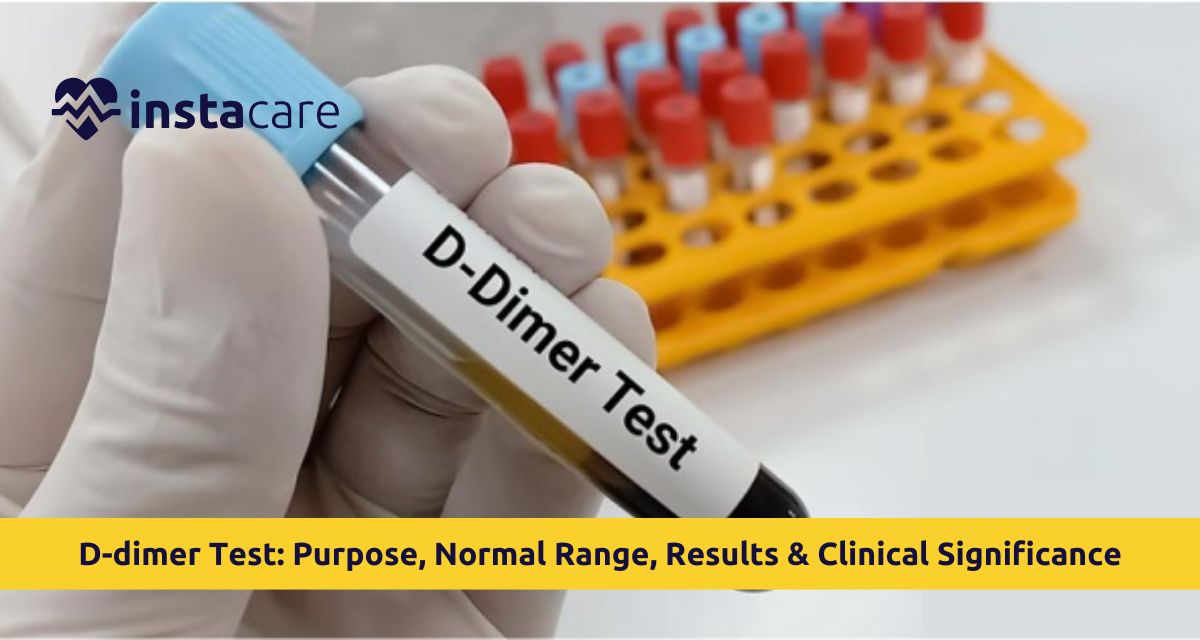What is a D-dimer Test?
D-dimer is a lab test for fibrin fragments, a protein in clots that remains after clots are broken down inside the body. "D-dimer" is the name of the specific protein fragment formed in this manner. It is done if clot disease is suspected, such as deep vein thrombosis, pulmonary embolism, or disseminated intravascular coagulation (DIC).
The definition of the D-dimer test is that it is being used as a rule-out test. A low or negative D-dimer result most typically is that a big blood clot is not likely. But it can't inform where the clot is or why the clot is occurring. So it's sometimes done along with imaging tests and clinical judgment.
Why is the D-dimer Test Performed?
Doctors prescribe a d-dimer test for blood clot diagnosis if a patient exhibits signs of swelling in the legs, chest pain, or breathing difficulties. These might be signs of life-threatening illnesses like:
COVID D-dimer test was prevalent during the COVID-19 pandemic since patients with abnormal results were more likely to develop clot complications.
A D-dimer test with high levels, i.e., d-dimer positive, indicates abnormal clotting and investigation is warranted. Elevated D-dimer is also due to surgery, pregnancy, infection, or liver disease, and the test result must therefore be interpreted cautiously.
How to Prepare for a D-dimer Test?
The preparation for D-dimer test is minimal. It is a standard blood test and can be done in a hospital, clinic, or diagnostic center. Try the following suggestions in order to prepare:
- You do not need to fast before the test.
- It is preferable to roll up the sleeve so that the arm can be accessed easily.
- Inform your doctor about any drugs or supplements, especially blood thinners.
There are no established risks for which the d-dimer blood test is ready, and safely it may be performed on outpatients and emergency departments.
D-dimer Test Procedure
- Your doctor or other health care professional inserts a small needle into a vein in your arm to obtain blood.
- Blood is piped into a tube and sent to the laboratory.
- Results typically take a few hours depending on the urgency.
Procedure is less than 10 minutes. In acute settings, D-dimer for blood clot is among the early tests to be ordered. D-dimer test sensitivity is excellent for excluding thrombosis in low-risk patients and not having clots.
What to Expect After the D-dimer Test?
No special aftercare is needed after the test. Rarely, bruising or tenderness in the puncture site in some individuals may result in a little bruising or soreness. Dizziness after blood is drawn is rare.
You can return to regular activities immediately unless instructed otherwise. If the test reveals high levels of D-dimer, further imaging studies like Doppler ultrasound or CT angiogram should be ordered to look for any potential clots.
No long-term effect or side effect is discovered from having a D-dimer blood test.
Interpreting D-dimer Test Results
D-dimer Test Normal Range
There must be a d-dimer test normal range below 0.50 µg/mL FEU for the D-dimer test. When the values of d-dimer test results fall within this range, one can predict that thrombotic event will not occur.
D-dimer Positive / High Values
A positive or high d-dimer levels result is a sign of active clotting and dissolution. This may be caused by:
- DVT or PE
- Recent trauma or surgery in the past
- Liver illness
- Inflammatory conditions
- Cancer
But a high level is nonspecific and needs to be interpreted in the context of symptoms and other diagnostic tests.
D-dimer Low Value
D-dimer low value is a positive finding, i.e., less chance of an injurious clot. It may exclude the necessity of subsequent invasive investigations.
The D-dimer test result is age, pregnancy, and other diseases related. Elderly patients may have a higher baseline normally.
Conditions Diagnosed using the D-dimer Test
D-dimer test uses in diagnosis are numerous. Illnesses diagnosed or excluded with the test are:
- Deep Vein Thrombosis (DVT) – Clots in the leg
- Pulmonary Embolism (PE) – Lung clots
- Stroke – When combined with brain imaging
- Disseminated Intravascular Coagulation (DIC) – Severe clotting disease
- Cardiovascular disease – Part of a larger cardiac work-up
The D-dimer test is most specific when utilized to exclude clotting in low-risk individuals. Testing must be repeated even if the test is negative in symptomatic or high-risk patients.
D-dimer Test vs. PT/INR
The D-dimer test vs PT INR contrast describes two relatively different yet complementary blood tests.
- D-dimer Test: Prevents active clotting and breakdown. It is a reactive test and utilized in diagnosis.
- PT/INR Test: Tests blood clotting time, primarily to follow anticoagulant treatment such as warfarin.
While D-dimer test for blood clot detects active conditions, PT/INR monitoring controls treatment on a daily basis. The two are run simultaneously for some conditions, D-dimer to assess clots and PT/INR to quantify blood-thinner dosage.
Determining the difference between D-dimer test vs PT INR makes appropriate treatment decisions.
Cost of D-dimer Test in Pakistan
D-dimer test cost in Pakistan depends on lab and emergency of results. Regular price is between PKR 2,500 to PKR 5,000. The cost may be higher for STAT or emergency.
Always verify if your medical cover involves the cost of D-dimer test, particularly if for hospitalization or emergency.
Home sampling facilities may be provided in private laboratory settings for even greater convenience, particularly for patients who were tested during COVID-19 or post-surgery.
Book lab tests from the
best-certified labs in Lahore, Karachi, Islamabad, and all major cities of Pakistan through
InstaCare, and get a discount of up to 35%. For assistance, call our helpline at 03171777509 to find the right lab test for your health needs.

